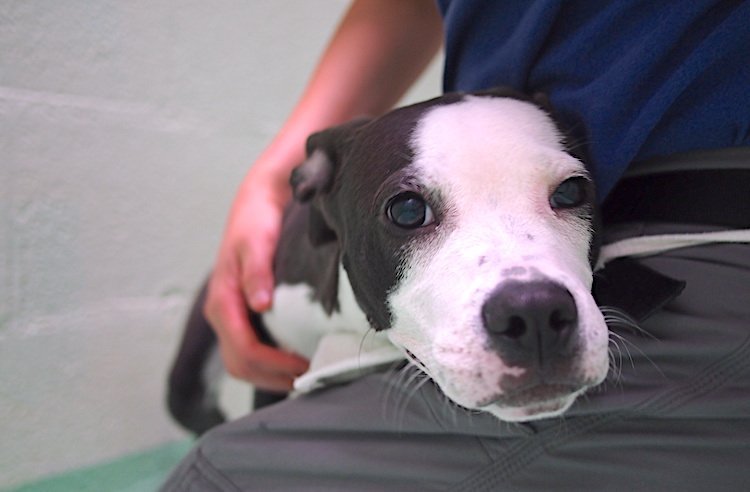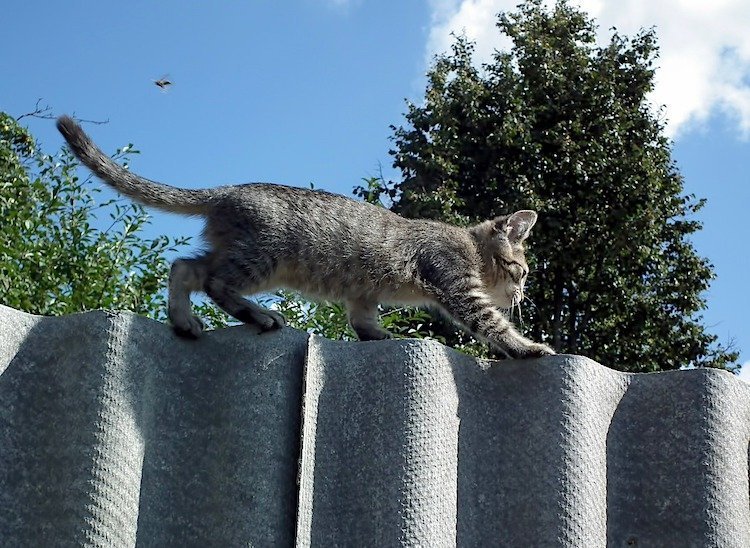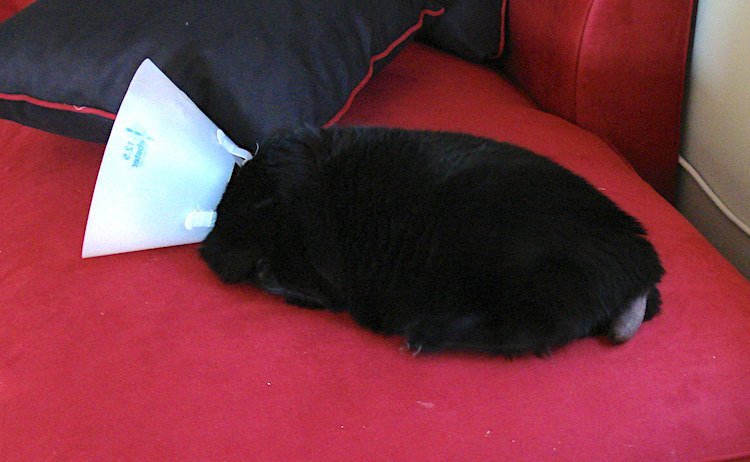
Tail injuries happen.
Whether your dog has “happy tail syndrome” or your cat’s tail has been crushed in a door, you may be facing tail amputation.
This may sound drastic, but most pets are back on their paws quickly and all the happier for no longer having a damaged tail.
To help you understand the whys and what-ifs of tail amputation, this article covers:
- Why the veterinarian wants to amputate your dog or cat’s tail
- What are the alternatives to tail amputation surgery?
- How we prevent phantom pain (and infection) in your pet
- What to expect from the surgical procedure
- How to prepare for the post-op period
- And why your pet will be happier in the long term
Please note that we will not discuss tail docking in this article, as it is a controversial topic and is considered unethical by the American Veterinary Medical Association.

6 Common Reasons for Tail Amputation in Dogs and Cats
Tails are wonderful things that help cats to balance and dogs to communicate. Then there’s the pleasure we all get from seeing the upright tail of a friendly approaching cat or the waggy blur of an excited dog.
So why would a vet suggest tail amputation?
The short answer: Because tail amputation is the best thing for the pet.
If the pet has a tail damaged beyond repair, they will be in constant pain or discomfort. Sometimes, sadly, the only way to deal with the problem is to remove the tail.
Fortunately, pets don’t have human hang-ups, they adapt well and they are pleased to no longer be in pain.
If you can’t foresee ever having to make this decision, think again. If your pet has a tail, there’s a chance they may injure it.
Of course the vet will consider all the other options first, but sometimes tail amputation is most definitely for the best.
Here are 6 common reasons tail amputation may be required:
1. Happy Tail Syndrome
The poster-dog for “happy tail syndrome” is the Labrador Retriever. If they’re awake, the Lab is wagging … it’s just a question of how hard.
The problem happens when the dog wags against an abrasive surface, such as a brick wall.
I’ve known one patient develop happy tail from wagging against a radiator in a hallway, and another from beating their tail (wagging!) against a garage wall.
What happens is the tail whips against an object, and this eventually breaks the skin. This is accompanied by lots of blood. But the dog doesn’t learn and continues to wag near the offending object, causing further tail trauma.
Was YOUR Pet Food Recalled?
Check Now: Blue Buffalo • Science Diet • Purina • Wellness • 4health • Canine Carry Outs • Friskies • Taste of the Wild • See 200+ more brands…

One option is to try tail dressing to protect the open wound. But these bandages are tricky to keep on and often get wagged off. Also, the scabs are itchy and the dog wants to chew, which adds another complication.
Sometimes, if after considerable effort the wound isn’t healing, then tail amputation may be necessary.
“Amputation works because of physics,” says Dr. Tony Johnson, DVM, DACVECC. “A shorter tail means less motion.”
2. Degloving Injuries
This is when the skin and fur gets peeled back from the tail bone, like taking a glove off a hand.
These injuries are usually caused by trauma, such as a traffic accident. Exposed bone soon gets infected, so the exposed tail bone must be removed.
3. Crush Injuries
The classic is the cat who ambles through a door … which then slams shut on their tail.
This happened to one of my cats. I was living in a flat above the surgery suite that had heavy fire doors that closed automatically. My cat, Skate, was a little too slow walking through said door, and got stuck fast by the tail.
Luckily, Skate didn’t crush any bones. He was left with a kink in his tail, but it could be saved.
Others pets aren’t so lucky — and if the tail is damaged beyond repair, then they’re happier without it.
4. Traumatic Nerve Damage to the Bladder
This typically happens when a cat has an accident that damages their pelvis or lower back.
If the nerve supply to the bladder is damaged and the tail hangs completely limp, then tail amputation may be advisable.
This is because of the weight of the “dead tail” pulling on the spinal cord. As the cat moves around, this risks further damage to the nerves and in the worst cases could imperil bladder and bowel function.
5. Phantom Pain and Tail Obsessions
Sometimes the nerves to the tail “remember” a previous pain and cause distress long after the original injury has healed.
This is known as phantom pain, and unfortunately it can cause pets to do terrible self-harm.
This happened to a cat adopted by our head nurse. The cat, Baxter, was a stray handed into the RSPCA. He had an infected wound on his tail, which he kept attacking.
Long after the infection healed, every time the Elizabethan collar (E collar, a.k.a. “cone of shame”) was taken off, Baxter immediately growled and bit his own tail again, as if it were attacking him.
In this same way, some animals develop an obsession with their tail and cause ongoing self-trauma.
Sadly, tail amputation may be needed as a treatment of last resort, along with good pain relief ahead of surgery (to numb the nerves that are causing the phantom pain).
6. Tail Tumors
The skin is tailored to the tail with nothing to spare.
If a pet has a large growth on their tail, then removing it is tricky because there’s simply not enough skin to fill in the hole, making tail amputation the only option.

Tail Amputation Alternatives
The vet will try hard to salvage the tail, before advising for amputation.
Typically, this involves assessing the extent of the injuries by:
- Radiographs to check for crushed bones
- Examining skin wounds under sedation or anesthesia
- Managing wounds with dressing, antibiotics and pain relief
- Preventing self-trauma with an E collar
However, not all cases respond.
And sadly, for those dogs or cats who are left with irreparable damage or who fail to respond, tail amputation is for the best.
This is because the tail is the end part of the spine, so it is full of nerves, and all of these injuries can cause significant pain.
When the wounds cannot be repaired or will not heal, or when the bandage stubbornly falls off, or when a dog wags their tail so hard that the tail keeps getting re-injured, then we may have to resort to tail amputation.
Preventing Phantom Pain After Tail Amputation
If the injury is painful, a wise vet gets on top of the pain before amputating. This can mean anything from giving a powerful painkiller with the pre-med, through to several days of pain-relieving medication before surgery is considered.
The reason this is important is to stop “nerve memory.”
This phenomenon was recognized after World War II, when pilots complained of ongoing pain in amputated limbs, long after surgery. The importance of removing pain ahead of removing the limb came to light and remains good practice.
To do this may require a cocktail of medications to really get on top of things. But this is a good investment in the pet’s future well-being.
In addition, the vet may want to get infection under control (although this isn’t always necessary) before going ahead.

Tail Amputation Surgery: What to Expect
For the majority of dogs and cats, tail amputation is day surgery — meaning they can go home that evening. (The exceptions are those patients with complications, such as trauma after a traffic accident).
As with most surgical procedures, you’ll need to forgo feeding your pet overnight, so they have an empty stomach ready for the anesthetic.
Not all tails have to be taken to a short stump, with some being salvaged to a length where the dog can still wag or the cat can still use it for balance. Usually the vet will let you know ahead of time how much will be removed.
Tail amputation requires a full general anesthetic and takes 20–40 minutes, depending on how high up the amputation is. The vet may place absorbable sutures, which dissolve on their own, so there’s less fiddling around when healing is complete.
Sometimes the remaining tail is bandaged, or it may be left open to the air. If the patient is able to reach the surgical site, then an E collar is a good idea to stop them from licking or chewing the wound.
The pet may look a little strange to you at first, because they’ll have hair shaved around the tail base and have a new silhouette. However, once the fur grows back, the stump can look super-cute, like a furry bobtail.
Your pet may have a post-op check 2–3 days later. This is when the vet makes sure the pet has recovered from the anesthetic and is eating normally. They’ll also check the area for infection and pain, and then supply any appropriate medications.
Healing is usually complete after 10–14 days, which is when any non-absorbable sutures will need to come out.
For much more information, see “Your Pet’s Surgery: An Expert Guide to What to Expect.”
Here’s a Bulldog who has undergone a medically necessary tail amputation:

What to Expect in the Long Term
If you’re worried about how your pet will cope without a tail, please don’t be.
The vast majority of dogs and cats never look back — indeed, they seem far happier afterward because they are no longer in pain:
- Yes, cats do use their tail for balance, but they soon compensate and adapt. During this period, it’s good to keep outdoor cats indoors so they can find their footing in a relatively safe environment. After that, they can usually get up to all their old tricks again.
- As for dogs, yes, they do use their tail for communication. In theory, this could make it more difficult for a strange dog to read your pup’s body language. When other people are responsible and keep their dogs under control, this shouldn’t cause a problem.
So, although tail amputation isn’t something you would ever wish on your pet, know that you are probably more anxious about it than they are.
Don’t worry: Like any other pet amputees, they will most likely adapt and quickly be back to their usual happy self.
References
- “Ear Cropping and Tail Docking of Dogs.” American Veterinary Medical Association. https://www.avma.org/KB/Policies/Pages/Ear-Cropping-and-Tail-Docking-of-Dogs.aspx.
- Walker, C., et al. “Balance in the Cat: Role of the Tail and Effects of Sacrocaudal Transection.” Behavioural Brain Research 91, no. 1–2 (March 1998): 41–47. https://pubmed.ncbi.nlm.nih.gov/9578438/.
- Johnson-Bennett, Pam. “Your Cat’s Tail: What it Says About Her Mood.” Cat Behavior Associates. 2016. https://www.catbehaviorassociates.com/your-cats-tail-what-it-says-about-her-mood/.
- Reimchen, Thomas, DPhil, and Stephen Leaver. “Behavioural Responses of Canis Familiaris to Different Tail Lengths of a Remotely-Controlled Life-Size Dog Replica.” Behaviour 145, no. 3 (Jan. 1, 2008): 377–390. https://brill.com/view/journals/beh/145/3/article-p377_7.xml.
- Coren, Stanley, PhD, DSc, FRSC. “Why Do Dogs Have Tails?” Psychology Today. Nov. 24, 2016. https://www.psychologytoday.com/us/blog/canine-corner/201611/why-do-dogs-have-tails.
- Buzhardt, Lynn, DVM. “Tail Injuries in Dogs.” VCA Hospitals. 2015. https://vcahospitals.com/know-your-pet/tail-injuries-in-dogs.
- Johnson, Tony, DVM, DACVECC. “The Infinite Sadness of Happy Tail.” VetzInsight from Veterinary Partner and VIN. Sept. 14, 2015. https://www.vin.com/vetzinsight/default.aspx?pid=756&catId=5860&id=6998567.
- Hattersley, Rachel, BVetMed, CertSAS, DipECVS, MRCVS. “Management of Canine and Feline Degloving Injuries.” Vet Times. Oct. 1, 2018. https://www.vettimes.co.uk/article/management-of-canine-and-feline-degloving-injuries/.
- Brooks, Wendy, DVM, DABVP. “Broken Tails in Cats Aren’t Always Obvious.” Veterinary Partner. Nov. 25, 2002. https://veterinarypartner.vin.com/default.aspx?pid=19239&catId=102903&id=4951820.
- Pendergrass, JoAnna, DVM. “New Insights Into the Phantom Complex for Small Animals.” American Veterinarian. Jan. 4, 2008. https://www.americanveterinarian.com/news/new-insights-into-the-phantom-complex-for-small-animals.
- Menchetti, Marika, DVM, PhD, et al. “Approaching Phantom Complex After Limb Amputation in the Canine Species.” Journal of Veterinary Behavior 22 (November–December 2017): 24–28. https://www.sciencedirect.com/science/article/abs/pii/S1558787817300904.
- Herold, Lee, DVM, DACVECC. “Caudectomy in the ER.” DoveLewis Emergency Animal Hospital. https://www.atdove.org/article/caudectomy-in-the-er.
 This pet health content was written by a veterinarian, Dr. Pippa Elliott, BVMS, MRCVS, with contributions from Dr. Phil Zeltzman, DVM, DACVS, CVJ, a board-certified veterinary surgeon. This article was last reviewed July 23, 2019.
This pet health content was written by a veterinarian, Dr. Pippa Elliott, BVMS, MRCVS, with contributions from Dr. Phil Zeltzman, DVM, DACVS, CVJ, a board-certified veterinary surgeon. This article was last reviewed July 23, 2019. 

